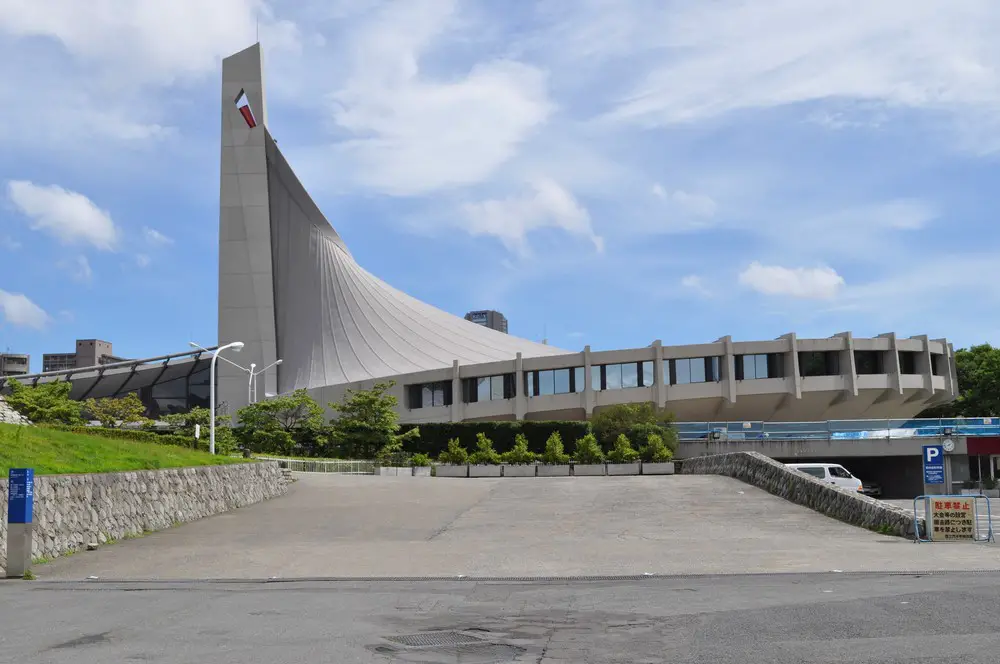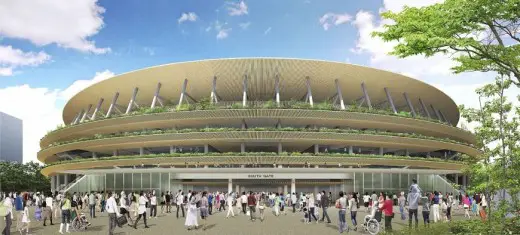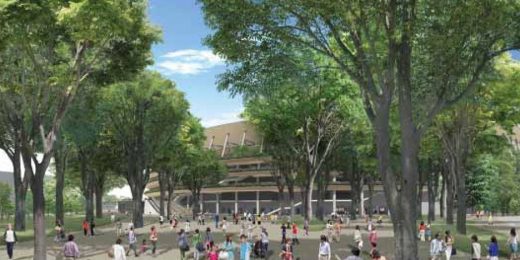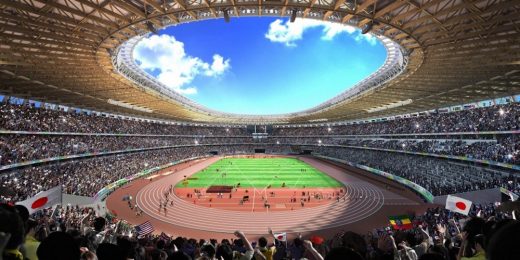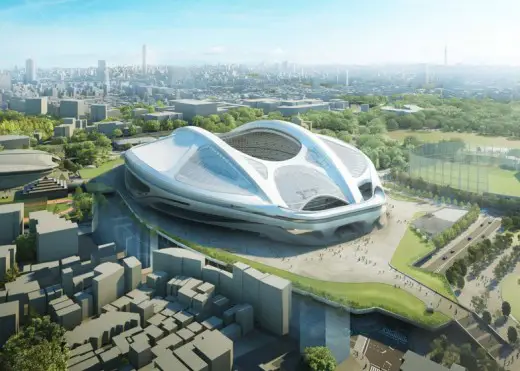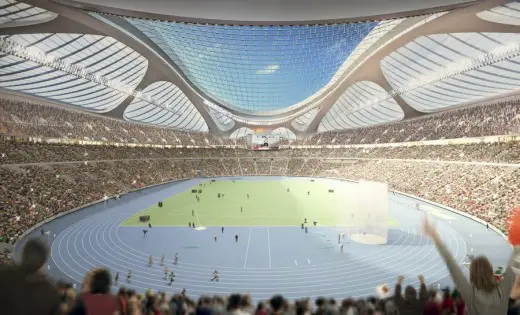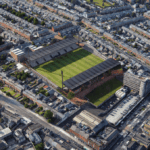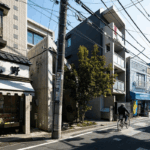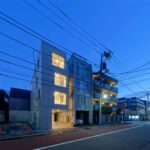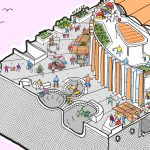Yoyogi National Gymnasium Tokyo Building, Japanese arena architecture news, Japan sports facility images
Yoyogi National Gymnasium Building in Tokyo
20th Century Sports Arena in Japan by Kenzo Tange Architect
Yoyogi National Gymnasium, Tokyo
Design: Architect Kenzo Tange
Japan Sport Council
Date built: 1964
Yoyogi National Gymnasium, Tokyo, One of Twelve Recipients of Getty Foundation’s Keeping It Modern Grants
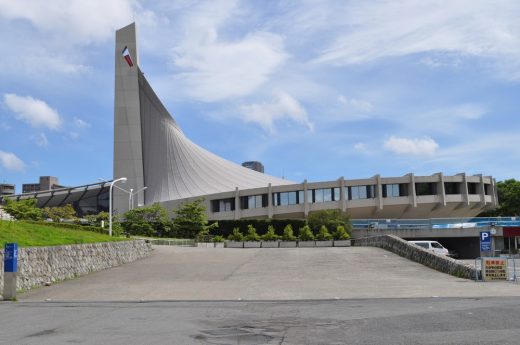
Photo courtesy Japan Sport Council
31 Jul 2017
Yoyogi National Gymnasium Tokyo Design
When Japan was preparing to host the first-ever Olympic Games in Asia in the early 1960s, the state commissioned eventual Pritzker Prize-winning architect Kenzo Tange to build a pivotal venue for the event. Tange responded with the Yoyogi National Gymnasium, two elegant concrete and steel buildings that gained immediate international recognition as masterpieces of modern architecture when their doors opened in 1964.
Yoyogi National Gymnasium’s state-of-the-art technology and exacting engineering, along with its elongated sweeping roofline, introduced a new modernism to Japan while still evoking the grace and timelessness of traditional Japanese architecture. With its spindle- or shell-like shape, Yoyogi National Gymnasium became a prime example of Japan’s Metabolist style, a postwar Japanese movement that explored architecture as a living and evolving organism.
Owned and operated by the Japan Sport Council, the gymnasium has been well cared for and has been continuously used for sports and cultural events. Looking ahead to 2020, Japan will host the Olympic and Paralympic Games and, once again, Yoyogi National Gymnasium—now part of a heritage zone focusing on the legacy of the 1964 Olympics—will be used for indoor sports competitions.
In order to ensure that any interventions meet heritage standards, the Japan Sport Council proposes a detailed study of the gymnasium, including its related historical archives, building materials, and the necessary functional upgrades to meet the needs of today’s visitors. The project will result in one of the first conservation management plans for modern architecture in the country.
Grant support: $150,000
Yoyogi National Gymnasium, Tokyo Building images / information from The Getty Foundation
Getty Foundation Keeping it Modern 2017 Grants
Location: Yoyogi National Gymnasium, Tokyo, Japan
20 May 2017
Tropical Forest Timber at New National Stadium Tokyo
Plywood at site of new Tokyo Olympic Stadium
Design: Kengo Kuma & Associates
The International Olympic Committee (IOC) and the Tokyo Olympic organizers have been repeatedly informed about the high risk of using illegal and unsustainable timber for Olympic construction.
previously on e-architect:
21 Apr 2017
Unethical Tropical Forest Plywood at New National Stadium Tokyo by Kengo Kuma
Tokyo’s wooden Olympic stadium using timber linked to rights abuses
Timber from a Malaysian logging giant accused of deforestation and human rights violations is being used to construct the wooden stadium that will be the centerpiece of Tokyo’s Olympic Games, said a group of charities.
An investigation by the charities this month twice found plywood from Sarawak-based Shin Yang at the National Stadium construction site – a breach of Japan’s pledge to host a sustainable Olympics in 2020, according to seven environmental and rights organizations.
Shin Yang, one of the “big six” logging companies on the Malaysian part of Borneo, has systematically cleared pristine rainforest from the Southeast Asian island, said a statement by charities, including Global Witness and Rainforest Action Network, released on Thursday.
Tokyo’s Olympic stadium will be constructed around an unusual set of wooden lattices – a design conceived by architect Kengo Kuma to harmonize with a forest of oak and camphor trees surrounding the nearby Meiji shrine in the Japanese capital.
According to a 2015 report by Global Witness, Shin Yang has cut down over 40 hectares of forest a day on Borneo, where half the plywood used in Japan’s building and furniture industries is produced.
Shin Yang is involved in a decade-long conflict in the central part of Malaysian Borneo, with the Penan indigenous minority. Community leaders told investigators for a 2014 report by the Human Rights Commission of Malaysia that forest clearance to create palm oil plantations violated their rights to traditional lands on which they depend for their livelihoods.
“Shin Yang is one of the most notorious exploiters of Sarawak’s tropical forests, and plywood from this company would fail to meet any sustainability criteria,” said Peg Putt, head of Markets for Change, one of charities.
The International Olympic Committee had agreed on a Sustainable Sourcing Code for Timber with Tokyo Metropolitan Government and National Government to assure venues for the games met ethical standards.
Japan Sport Council (JSC), the government body in charge of building Olympic competition venues, said Shin Yang timber was being used.
But both JSC and Taisei, the building company leading the stadium’s construction, told Thomson Reuters Foundation all timber on site meets requirements laid out in the code.
Hana Heineken of Rainforest Action Network said a provision in the code exempted cheap plywood used to shape concrete from the sustainable sourcing regulations.
According to the report from the Human Rights Commission of Malaysia, Shin Yang deforestation threatened local communities’ ability to continue traditional ways of life in the forest, and recommended the government step in to protect the Penans, one of the country’s most marginalized groups.
source: Tokyo’s wooden Olympic stadium using timber linked to rights abuses Reuters article in full
17 + 16 Jan 2016
Tokyo Olympic Stadium Architect Denies Plagiarising Zaha Hadid
Tokyo 2020 Olympic stadium architect Kengo Kuma rejects accusations that he stole the design from Zaha Hadid, reports The Guardian today.
New National Stadium Tokyo design by Kengo Kuma & Associates:
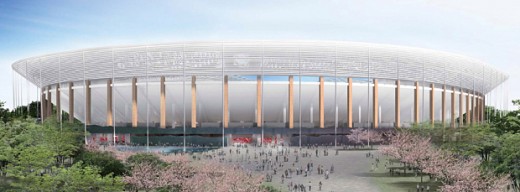
New National Stadium Tokyo Design by Kengo Kuma & Associates
For reference: New National Stadium Tokyo Design by Zaha Hadid Architects, published September 18, 2015 ; updated on November 4, 2015:
15 + 22 Dec 2015
New National Stadium Tokyo Winning Design
Winning Design Proposals for New Olympic Stadium in Tokyo
The winning proposal, formerly known as design A, was submitted by a joint venture comprised of an architect, construction firm Taisei Corp. and construction support firm Azusa Sekkei Co.
Statement by Zaha Hadid on New Olympic Stadium in Tokyo Design
Zaha Hadid
Tokyo Olympic Stadium Architect Denies Plagiarising Zaha Hadid – 16 Jan 2016
New National Stadium in Tokyo video presentation from Zaha Hadid Architects on Vimeo
Zaha Hadid Architects have not been able to secure a construction company in its consortium and therefore announce that they are unable to enter the competition.”
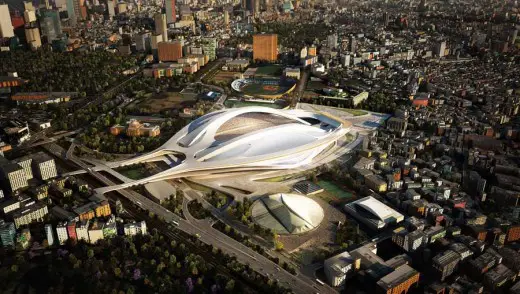
image © Courtesy of Zaha Hadid Architects
Zaha Hadid Architects: “It is disappointing that the two years of work and investment in the existing design for a new National Stadium for Japan cannot be further developed to meet the new brief through the new design competition.
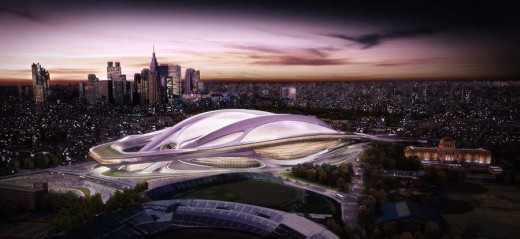
image © Courtesy of Zaha Hadid Architects
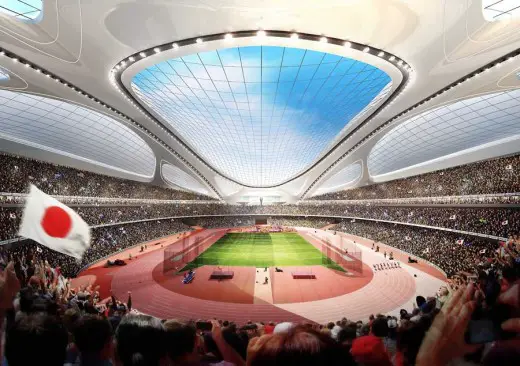
image © Courtesy of Zaha Hadid Architects
Kasumigaoka National Stadium Tokyo information received from ZHA
Opened: October 1964
Capacity: 13,291 (1st Gymnasium); 3,202 (2nd Gymnasium)
Owner: Japan Sport Council
Address: 2 Chome-1-1 Jinnan, Shibuya, Tokyo 150-0041, Japan
Phone: +81 3-3468-1171
Tokyo Architecture
Kasumigaoka National Stadium Tokyo by ZHA – 27 May 2014
Tokyo Architecture Selection
Tokyo Architecture Designs – chronological list
Japanese Architect Offices
Tokyo Building Designs – Selection
Mode Gakuen Cocoon Tower
Design: Tange Associates Architects
Mode Gakuen Cocoon Tower
Ginza Natsuno R Building
Design: TNA Architects
Ginza Natsuno R Building
Alexandre Herchcovitch
Design: Studio Arthur Casas, Architects
Alexandre Herchcovitch Tokyo Store
Comments / photos for the Yoyogi National Gymnasium, Tokyo, Japan page welcome

